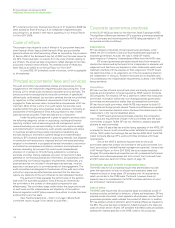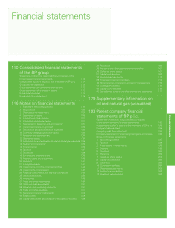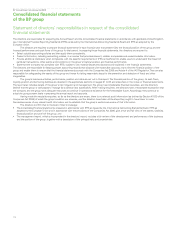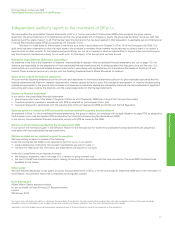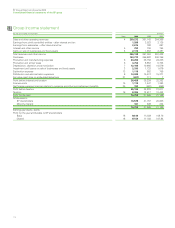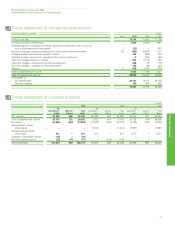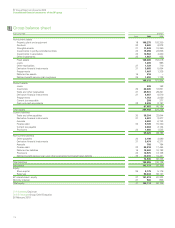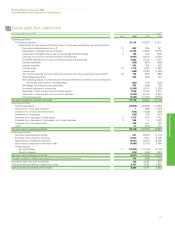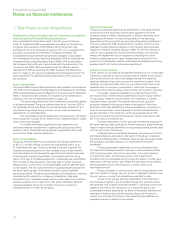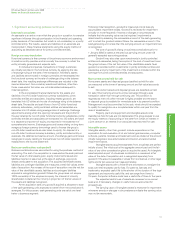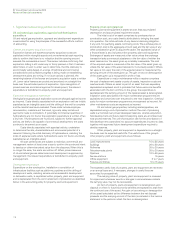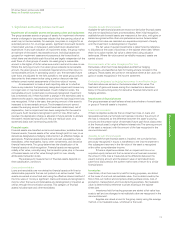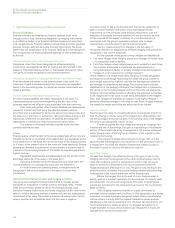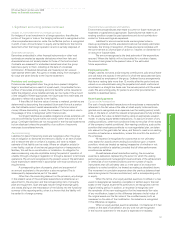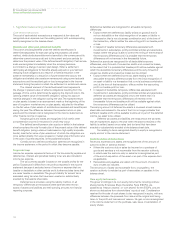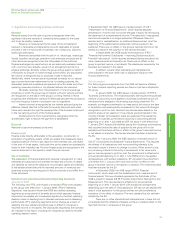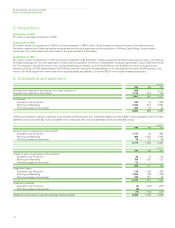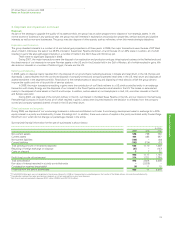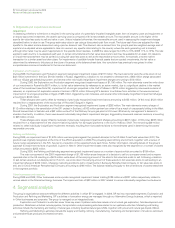BP 2009 Annual Report Download - page 118
Download and view the complete annual report
Please find page 118 of the 2009 BP annual report below. You can navigate through the pages in the report by either clicking on the pages listed below, or by using the keyword search tool below to find specific information within the annual report.
116
BP Annual Report and Accounts 2009
Notes on financial statements
1. Significant accounting policies
Authorization of financial statements and statement of compliance
with International Financial Reporting Standards
The consolidated financial statements of the BP group for the year
ended 31 December 2009 were approved and signed by the chairman
and group chief executive on 26 February 2010 having been duly
authorized to do so by the board of directors. BP p.l.c. is a public limited
company incorporated and domiciled in England and Wales. The
consolidated financial statements have been prepared in accordance
with International Financial Reporting Standards (IFRS) as issued by the
International Accounting Standards Board (IASB), IFRS as adopted by
the European Union (EU) and in accordance with the provisions of the
Companies Act 2006. IFRS as adopted by the EU differs in certain
respects from IFRS as issued by the IASB, however, the differences
have no impact on the group’s consolidated financial statements for the
years presented. The significant accounting policies of the group are
set out below.
Basis of preparation
The consolidated financial statements have been prepared in accordance
with IFRS and International Financial Reporting Interpretations Committee
(IFRIC) interpretations issued and effective for the year ended 31 December
2009, or issued and early adopted. The standards and interpretations
adopted in the year are described further on page 123.
The accounting policies that follow have been consistently applied
to all years presented. The group balance sheet as at 1 January 2008 is
not presented as it is not affected by the retrospective adoption of any
new accounting policies during the year, nor any other retrospective
restatements or reclassifications.
The consolidated financial statements are presented in US dollars
and all values are rounded to the nearest million dollars ($ million), except
where otherwise indicated.
For further information regarding the key judgements and
estimates made by management in applying the group’s accounting
policies, refer to Critical accounting policies on pages 94 to 96, which
forms part of these financial statements.
Basis of consolidation
The group financial statements consolidate the financial statements
of BP p.l.c. and the entities it controls (its subsidiaries) drawn up to
31 December each year. Control comprises the power to govern the
financial and operating policies of the investee so as to obtain benefit
from its activities and is achieved through direct and indirect ownership
of voting rights; currently exercisable or convertible potential voting
rights; or by way of contractual agreement. Subsidiaries are consolidated
from the date of their acquisition, being the date on which the group
obtains control, and continue to be consolidated until the date that such
control ceases. The financial statements of subsidiaries are prepared for
the same reporting year as the parent company, using consistent
accounting policies. All intercompany balances and transactions, including
unrealized profits arising from intragroup transactions, have been
eliminated in full. Unrealized losses are eliminated unless the transaction
provides evidence of an impairment of the asset transferred. Minority
interests represent the portion of profit or loss and net assets in
subsidiaries that is not held by the group.
Segmental reporting
The group’s operating segments are established on the basis of those
components of the group that are evaluated regularly by the chief
operating decision maker in deciding how to allocate resources and in
assessing performance. The accounting policies of the operating
segments are the same as the group’s accounting policies described in
this note, except that IFRS requires that the measure of profit or loss
disclosed for each operating segment is the measure that is provided
regularly to the chief operating decision maker. For BP, this measure of
profit or loss is replacement cost profit before interest and tax which
reflects the replacement cost of supplies by excluding from profit
inventory holding gains and losses. Replacement cost profit for the
group is not a recognized measure under generally accepted accounting
practice (GAAP). For further information see Note 4.
Interests in joint ventures
A joint venture is a contractual arrangement whereby two or more parties
(venturers) undertake an economic activity that is subject to joint control.
Joint control exists only when the strategic financial and operating
decisions relating to the activity require the unanimous consent of the
venturers. A jointly controlled entity is a joint venture that involves the
establishment of a company, partnership or other entity to engage in
economic activity that the group jointly controls with its fellow venturers.
The results, assets and liabilities of a jointly controlled entity
are incorporated in these financial statements using the equity method
of accounting. Under the equity method, the investment in a jointly
controlled entity is carried in the balance sheet at cost, plus post-
acquisition changes in the group’s share of net assets of the jointly
controlled entity, less distributions received and less any impairment in
value of the investment. Loans advanced to jointly controlled entities
are also included in the investment on the group balance sheet. The
group income statement reflects the group’s share of the results after
tax of the jointly controlled entity.
Financial statements of jointly controlled entities are prepared for
the same reporting year as the group. Where necessary, adjustments are
made to those financial statements to bring the accounting policies used
into line with those of the group.
Unrealized gains on transactions between the group and its jointly
controlled entities are eliminated to the extent of the group’s interest in
the jointly controlled entities. Unrealized losses are also eliminated unless
the transaction provides evidence of an impairment of the asset
transferred.
The group assesses investments in jointly controlled entities
for impairment whenever events or changes in circumstances indicate
that the carrying value may not be recoverable. If any such indication
of impairment exists, the carrying amount of the investment is
compared with its recoverable amount, being the higher of its fair value
less costs to sell and value in use. Where the carrying amount exceeds
the recoverable amount, the investment is written down to its
recoverable amount.
The group ceases to use the equity method of accounting on the
date from which it no longer has joint control or significant influence over
the joint venture, or when the interest becomes held for sale.
Certain of the group’s activities, particularly in the Exploration
and Production segment, are conducted through joint ventures where
the venturers have a direct ownership interest in, and jointly control, the
assets of the venture. BP recognizes, on a line-by-line basis in the
consolidated financial statements, its share of the assets, liabilities and
expenses of these jointly controlled assets, along with the group’s
income from the sale of its share of the output and any liabilities and
expenses incurred in relation to the venture.


